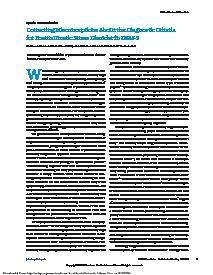Correcting Misconceptions About the Diagnostic Criteria for Posttraumatic Stress Disorder in DSM-5
This Special Communication argues for changing the definition of posttraumatic stress disorder in DSM-5. Are changes to the definition of posttraumatic stress disorder in DSM-5 a step forward?—Yes.
We take strong exception to many of the assertions, conclusions, and recommendations in the article by Hoge et al1 in this issue of JAMA Psychiatry. Although Hoge et al1 identify a number of reasons they do not support the DSM-52 workgroup’s revisions to the diagnosis of posttraumatic stress disorder (PTSD), we believe that their basic arguments are that
(1) there was insufficient evidence for making changes to the DSM-IV3 criteria and
(2) any change in a diagnosis is bad because it requires modification in assessment instruments and causes discordant diagnoses between the old and new criteria.
We further believe that our colleagues mischaracterized the DSM-5 revision process, which required strong empirical support to justify any change. They also neglected to mention limitations and criticisms of the DSM-IV criteria, omitted findings supporting the clinical and scientific utility of the DSM-5 criteria, and grossly exaggerated potential harm to the field of using the DSM-5 criteria.
Geachte bezoeker,
De informatie die u nu opvraagt, kan door psychotraumanet niet aan u worden getoond. Dit kan verschillende redenen hebben,
waarvan (bescherming van het) auteursrecht de meeste voorkomende is. Wanneer het mogelijk is om u door te verwijzen naar de bron
van deze informatie, dan ziet u hier onder een link naar die plek.
Als er geen link staat, kunt u contact opnemen met de bibliotheek,
die u verder op weg kan helpen.
Met vriendelijke groet,
Het psychotraumanet-team.
In: JAMA Psychiatry, ISSN 2168-622X | 73 | 7 | 753-754
http://doi.org/10.1001/jamapsychiatry.2016.0745


